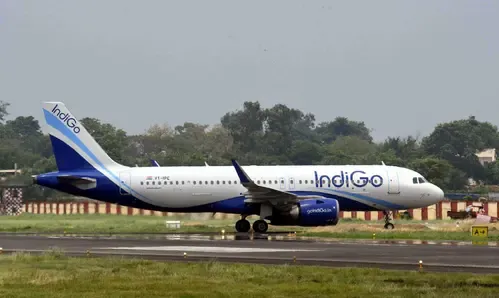What Happened to the Raipur-bound IndiGo Flight?

Synopsis
Key Takeaways
- IndiGo flight encountered a technical snag shortly after takeoff.
- Emergency landing was executed safely back in Indore.
- All 51 passengers were unharmed during the incident.
- The airline provided refunds or rescheduling options to affected passengers.
- Concerns have been raised regarding airline safety protocols.
Indore, July 8 (NationPress) An IndiGo flight en route to Raipur from Indore turned into a distressing situation for 51 passengers on Tuesday when it encountered a technical issue and had to make an emergency landing shortly after takeoff. The flight, usually set to take off at 6:35 a.m., departed seven minutes ahead of schedule at 6:28 a.m. from Devi Ahilyabai Holkar Airport.
Approximately 30 minutes into the flight, nearly 100 kilometers from the Indore airport, the aircraft reportedly experienced a sudden jolt, leading to panic among those aboard.
Passengers described the alarming moment when the aircraft shook unexpectedly, triggering widespread fear.
The pilot promptly communicated with Indore Air Traffic Control (ATC) after receiving erroneous technical alerts in the cockpit and requested clearance to return.
The aircraft safely landed back in Indore at 7:15 a.m., with all passengers deplaning without injury.
In the aftermath of the incident, airline officials canceled the flight and provided passengers with the option of a full refund or rescheduling.
While airport representatives suggested that the alerts were likely false alarms, maintenance teams have initiated an internal review of the aircraft to determine the cause and avert similar occurrences in the future. This incident follows a similar event just 15 days prior, on June 23, when IndiGo's Airbus A320 Neo, designated as flight 6E 6332 from Indore to Bhubaneswar, had to return to the runway due to a technical malfunction. In that instance, over 80 passengers remained onboard for more than two hours while the issue was resolved.
The recurrence of such incidents has raised renewed apprehensions among travelers regarding safety protocols.
While no injuries were reported in either situation, the prompt and coordinated actions of the flight crew and airport personnel have been acknowledged.
Nevertheless, aviation experts and frequent travelers are advocating for a comprehensive review of maintenance and alert systems, especially in light of these consecutive safety issues.









